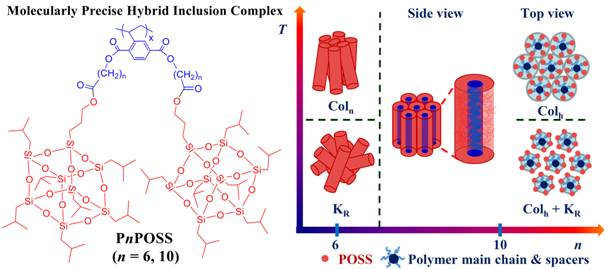Organic−inorganic hybrid nanomaterials with different length scales, compositions, functionalities, and morphologies offer prospects for both scientific research and innovative industrial applications owing to their remarkable, new properties and multifunctional nature. However, it is quite challenging to obtain hybrid inclusion complexes having well-defined structures with polymer chains embedded in the channels of inorganic porous materials. A research group from the Department of Polymer Science and Engineering in the College of Chemistry and Molecular Engineering at Peking university has designed and synthesized a series of hierarchically ordered organic−inorganic hybrid polymers from mesogen-jacketed polymers (MJLCPs) and the inorganic nanoparticle POSS. Their research has been published in Macromolecules on April 28, 2015.
The group synthesized these new organic−inorganic hybrid polymers containing flexible alkyl spacers of different lengths. The precisely defined chemical structures of the hybrids are ensured by the covalent linking nature of the POSS-containing styrene-type monomers from which the polymers were obtained by free radical polymerization. The intriguing phase structures of the MJLCPs containing the 3D POSS nanobuilding blocks in the side chains were formed from the competitive self-assemblies of the MJLCP and the POSS nanobuilding block. Furthermore, flexible spacers with different lengths are used to tune the self-assembled structures, and a high POSS content is necessary for forming the crystalline POSS matrix of the inclusion complex.

Structures of these new organic−inorganic hybrid polymers, determined at 4.49 nm using synchrotron radiation at BSRF. In these polymers, POSS was connected to polymer main-chain covalently. The diameter of POSS is ~1 nm, while the size of each repeating unit is ~0.25 nm. Therefore, the polymer chain is surrounded by eight POSS units, making the polymer chain rod-like to form hexagonal columnar (Colh) phase with a = 4.49 nm.
The intriguing phase structure of the MJLCP containing the 3D POSS nanobuilding block is formed from the competitive and synergetic self-assemblies of the MJLCP chain as a whole and the POSS nanobuilding block. In addition, the length of the flexible spacer offers a way to control the structure of the resulting polymer. The competitive effect is dominant in the polymer with a shorter flexible spacer, and the POSS crystal and the polymer liquid crystalline (LC) phase could not coexist with each other. However, the competitive effect is rather weak in the polymer with a longer flexible spacer. The synergetic effect of the POSS crystal and the LC phase results in the formation of the Colh phase at sub−10 nm scale with the polymer main-chain inserting into the POSS matrix, and the POSS units form the rhombohedral crystalline structure (KR) on the angstrom scale simultaneously.
In the work, the technique carried out at 1W2A-SAXS station of BSRF plays a vitally important role in resolving the complex, hierarchical structures of the abovementioned inclusion complexes. Prof. Xinghe Fan and Prof. Zhihao Shen in the Department of Polymer Science and Engineering of the College of Chemistry and Molecular Engineering at Peking University believe that this work may open a new avenue for preparing polymer materials with hierarchically ordered structures on the sub-10 nm scale owing to the large variety of functional polymers and nanobuilding blocks.
Article:
Yu-Feng Zhu, Wei Liu, Meng-Yao Zhang, Yu Zhou, Yu-Dong Zhang, Ping-Ping Hou, Yu Pan, Zhihao Shen,* Xing-He Fan,* and Qi-Feng Zhou POSS-Containing Jacketed Polymer: Hybrid Inclusion Complex with Hierarchically Ordered Structures at Sub-10 nm and Angstrom Length Scales. Macromolecules 48(2015), 2358–2366.


